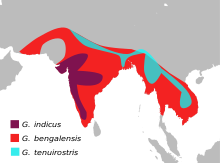Slender-billed Vulture
| Slender-billed Vulture | |
|---|---|
 | |
| Head of Gyps tenuirostris | |
| Conservation status | |
| Scientific classification | |
| Kingdom: | Animalia |
| Phylum: | Chordata |
| Class: | Aves |
| Order: | Falconiformes (or Accipitriformes, q.v.) |
| Family: | Accipitridae |
| Genus: | Gyps |
| Species: | G. tenuirostris |
| Binomial name | |
| Gyps tenuirostris Hodgson (in Gray), 1844 | |
 | |
| Distribution range in blue | |
| Synonyms | |
Gyps indicus tenuirostris
Gyps indicus nudiceps | |
The Slender-billed Vulture (Gyps tenuirostris) is a recently recognized species of Old World vulture. For some time, it was categorized with its relative, the Indian Vulture, under the name of "Long-billed Vulture". However, these two species have non-overlapping distribution ranges and can be immediately told apart by trained observers, even at considerable distances. The Indian Vulture is found only to the south of the Ganges and breeds on cliffs while the Slender-billed Vulture is found along the Sub-Himalayan regions and into Southeast Asia and nests in trees.
Description
At 80 to 95 cm (31 to 37 in), in length, this mid-sized vulture is about the same size as its sister species, the Indian Vulture. This vulture is mostly grey with a pale rump and grey undertail coverts. The thighs have whitish down. The neck is long, bare, skinny and black. The black head is angular and narrow with the dark bill appearing narrow midway. The ear opening is prominent and exposed.
Distribution and habitat
The Slender-billed Vulture is found in India from the Gangetic plain north, west toHimachal Pradesh, south potentially as far as northern Orissa, and east throughAssam. It is also found in north and central Bangladesh, southern Nepal, Burma andCambodia.
Status
Status
This species has suffered a marked decline in its numbers in recent years. Wild populations remain from northern and eastern India through southern Nepal andBangladesh, with a small population in Burma. The only breeding colony in Southeast Asia is in the Steung Treng province of Cambodia. This colony is thought to number about 50–100 birds. The survival of the vultures in Cambodia may have been partly because diclofenac, which is poisonous to vultures, is not available there. The Royal Society for the Protection of Birds (RSPB) has placed the approximate number of slender-billed vultures living beyond confines at about 1,000 in 2009 and predictions estimate total extinction within the next decade amongst the wild population.
Conservation
The Slender-billed vulture is a protected species listed on the appendix II list of CITES, because its numbers have declined rapidly. Its decline is largely due to the use of the non-steroidal anti-inflammatory drug (NSAID) diclofenacin working farm animals, especially in India. Diclofenac is poisonous to vultures, causing kidney failure, and is being replaced by meloxicam(another NSAID), which is not toxic to vultures. The retail sale of Diclofenac is banned by law in India; however, Diclofenac is still acquired illegally and applied to livestock.
Captive-breeding programs in India are aiming to conserve the species, and it is hoped that vultures can be released back in the wild when the environment is free of diclofenac. Joint efforts between the RSPB and the Zoological Society of London resulted in the first successful captive breeding in 2009.Two Slender-billed Vultures hatched and are being independently cared for in Haryana and West Bengal.

No comments:
Post a Comment